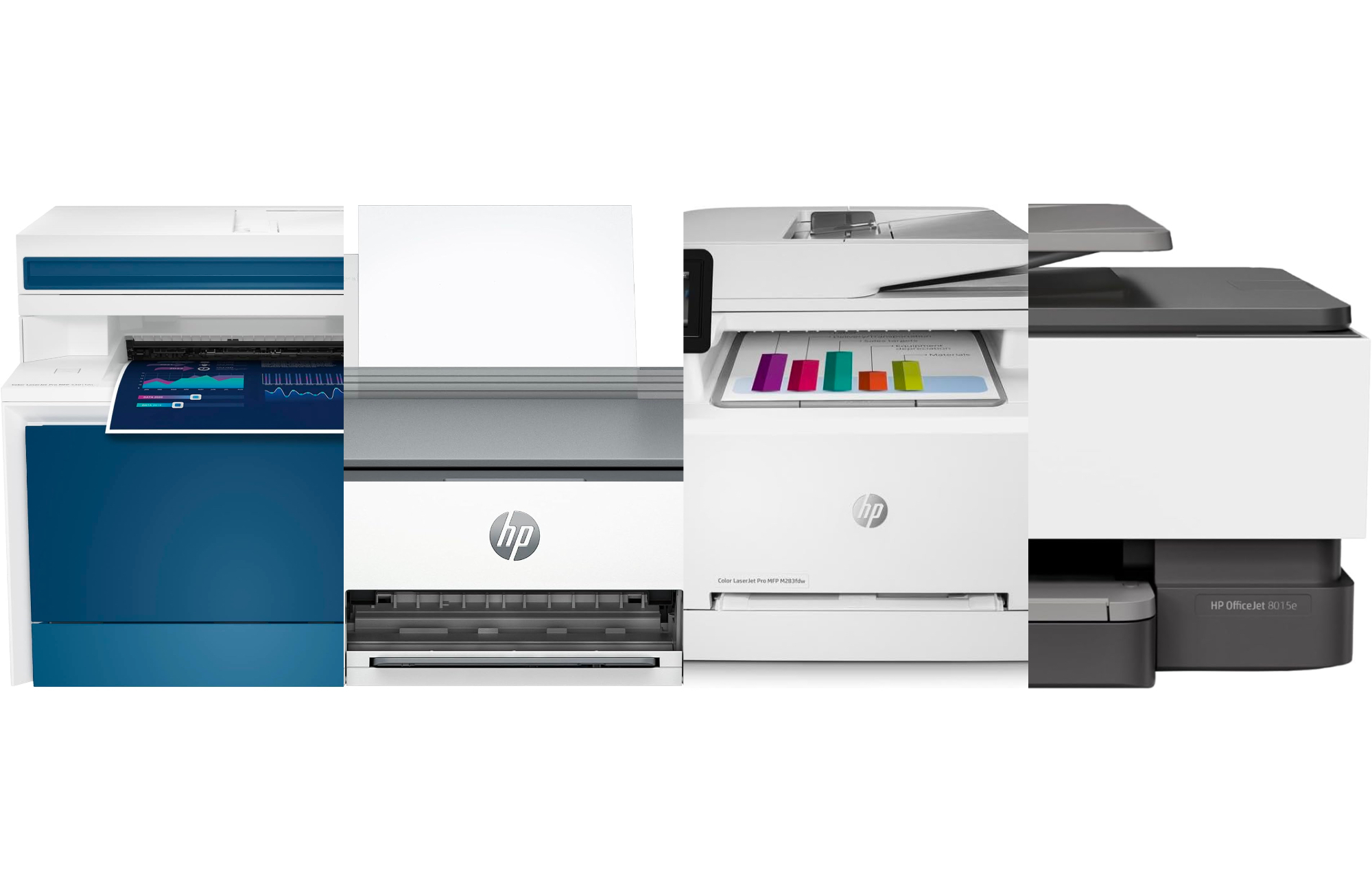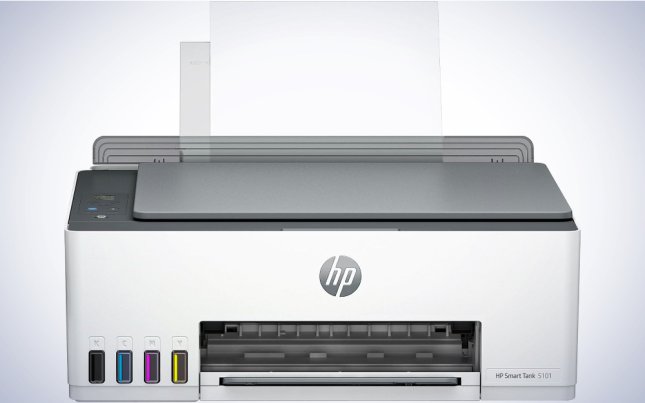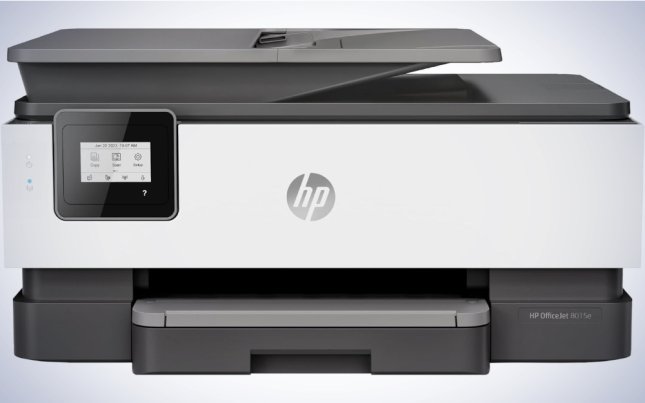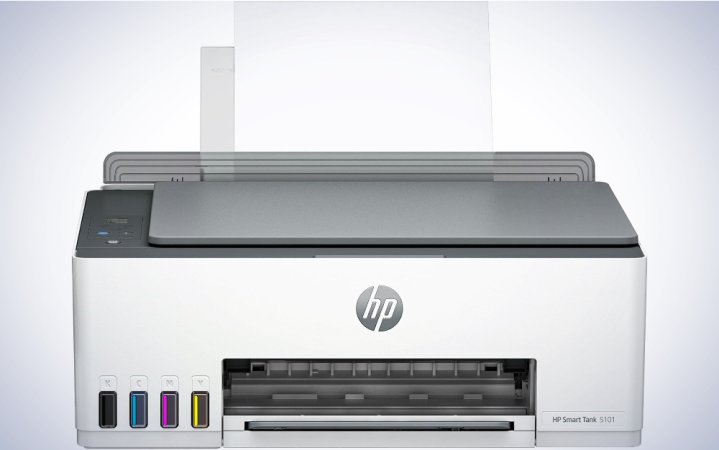We may earn revenue from the products available on this page and participate in affiliate programs. Learn more ›

An HP printer is a home office or dorm room essential that’ll make professional and personal projects a quick, simple affair. Yes, the world has largely gone digital, but there are still times when you’ll need to present a signed hard copy of a document to someone or want to print out a photo. You may need to make a quick copy or scan of an item, and it can be annoying to leave your home and pay for each page you print. The best HP printers will handle your print jobs, both big and small, reliably for years to come.
- Best overall: HP Smart-Tank 5101
- Best splurge: HP LaserJet Pro 4301
- Best laser printer: HP Color LaserJet Pro M283
- Best eco-friendly: HP Smart -Tank 7602
- Best budget: HP OfficeJet 8015e
How we chose the best HP printers
Our HP printer recommendations are based on a mix of hands-on testing and in-depth research. We considered multifunctionality, page capacity, and print speed most highly when determining our picks. The good news is that many features, like WiFi connectivity, have become standard over the years. Similarly, screens have made their way onto most HP printers, which allow you to operate and troubleshoot them more quickly. Finally, every HP printer we recommend is an “all-in-one” model, which means it can also copy and scan documents. This multifunctionality is important as it allows you to use a printer to its full potential.
The best HP printers: Reviews & Recommendations
Hewlett-Packard is a trusted name in laptops, and its reputation for reliability and value extends to peripherals. Prepared to take your digital documents and photos into the real world? Equip yourself with one of these HP printers for the smoothest experience.
Best overall: HP Smart-Tank 5101
HP Smart-Tank 5101
Pros
- Solid text and photo print quality
- Runs on ink tanks
- Made from 45% recycled plastic
Cons
- No double-sided printing
Specs
- Printer type: Inkjet
- Print speed: Up to 12 pages per minute
- Paper capacity: 100 sheets
HP’s Smart-Tank 5101 is among the most classic-looking HP printers we’re recommending, and that’s arguably its greatest strength. It won’t take up too much space and will look natural on the desk in a home office or dorm setting. A key difference between the 5101 and the printers of old is that it uses ink tanks rather than cartridges. These tanks allow you to print way more pages (HP says up to 6000 black and white or color pages) without needing to be refilled. If you’re more of an occasional printer, the included tanks could last several years.
Setting up the Smart-Tank was simple and done through the HP Smart app on iOS. The app found the printer wirelessly, configured it, and allowed us to add it to our WiFi network. Once connected, it was discoverable by a Mac, iPad, and iPhone. HP says the Smart-Tank 5101 prints at a rate of up to 12 black and white pages and five color pages per minute, and that was our experience. It doesn’t support double-sided printing, which isn’t a deal breaker but would have been nice to have.
We printed a mix of text and photos and found the quality of both to be pretty good. There are HP printers that could print colors more vividly, but this is an all-around model that wasn’t design specifically for that task. Sharp-eyed printers may be able to see the color difference between what’s shown on the screen and the page, but they’re not way off. This printer’s best feature was its reliability, which can tricky for printers, which are notoriously finicky. The Smart-Tank 5101 never lost its connection to our home network and printed all of the jobs we sent to it without hitching or throwing back annoying errors.
You can’t go wrong with HP’s Smart-Tank 5101 if you want a standard-looking but well-performing all-in-one printer.
Best splurge: HP LaserJet Pro 4301
HP LaserJet Pro 4301
Pros
- High print speed
- Large touch screen
- Consistent prints
Cons
- Size
- Price
Specs
- Printer type: Laser
- Print speed: Up to 35 pages per minute
- Paper capacity: 250 sheets
HP’s LaserJet Pro 4301 was the most impressive printer we’ve tested, and given its near-$700 price tag, it should be. One of our favorite features was this printer’s massive screen, which allowed us to set the printer up without using HP’s app. We could easily navigate to its WiFi settings, input our password, and be ready for wireless printing within a couple of minutes. Having immediate access to all the printer’s core functions was equally helpful when testing.
The LaserJet Pro 4301 routinely handled 50+ page print jobs with aplomb, barely making a sound as it cranked through dozens of pages at a clip. What was remarkable was not only the printers speed but also its consistency. There were no smudges when printing multicolor pages one after another, even though they came out hot. That’s the benefit of laser printers, which use powdered toner, which dries instantly, rather than ink.
If you’re running a small business or need to print hundreds of pages regularly, HP’s LaserJet Pro 4301 is a worthwhile investment. However, its size and price make it impractical for those with more modest needs.
Best laser printer: HP Color LaserJet Pro M283
HP Color LaserJet Pro M283
Pros
- Fast print speed
- High paper capacity
- Consistent prints
Cons
- Size
- Price
Specs
- Printer type: Laser
- Print speed: Up to 22 pages per minute
- Paper capacity: 250 sheets
HP’s Color LaserJet Pro M283 has all the features we appreciated during our tests of the 4301, but it’s hundreds of dollars less expensive. It’s a little slower, and its screen is a little smaller, but those are the main differences. You’re still left with a printer far faster than its Inkjet brethren, can be set up from the device itself rather than HP’s mobile app, and will create dozens of prints at once without sacrificing print quality. This model even works with Amazon’s Alexa, so you can begin print jobs totally hands-free if you want to.
One feature the LaserJet Pro M283 has that its older sibling lacks is a USB-A port on its front side, which allows you to print documents and photos off a flash drive. This is convenient if you’d like to begin a print job from a computer that isn’t connected to your network for some reason or if you don’t want to connect your printer to WiFi for whatever reason. This failsafe is especially helpful if your Internet goes out. If you’d like the benefits of a laser printer without breaking the bank, HP’s LaserJet Pro M283 is the right choice.
Best eco-friendly: HP Smart-Tank 7602
HP Smart-Tank 7602
Pros
- Runs on ink tanks
- High paper capacity
- Relatively fast print speed
Cons
- Small screen
Specs
- Printer type: Inkjet
- Print speed: Up to 15 pages per minute
- Paper capacity: 250 sheet tray
HP’s Smart-Tank 7602 is the more luxe version of our top pick, and it has all the features of our top pick and more. It can print at speeds up to 15 pages per minute, which is very impressive for an Inkjet printer, though it’s still not as fast as the laser printers we’re recommending. It supports double-sided printing and runs on ink tanks, which are far more eco-friendly than cartridges because they don’t have to be replaced as often. What’s more, HP says 25% of this printer is made from recycled materials.
HP says this printer can print up to 6,000 black and white or 8,000 color sheets with the set of ink tanks included. Those extra 2,000 color sheets make this a particularly eco-friendly choice compared to other HP printers. A USB-A port on this printer’s front side can be used for offline printing, though many will opt to connect the Smart-Tank 7602 to their home network over WiFi or Ethernet. Our only complaint is that this printer has a matte touch panel on its top side rather than a screen.
They’re functionally identical, but operating a printer using a display rather than that panel is easier. It’s a small nitpick for such a good printer, though, and shouldn’t deter you from picking one up.
Best budget: HP OfficeJet 8015e
HP OfficeJet 8015e
Pros
- Exceptional print speed for an Inkjet printer
- Made from partially recycled materials
- Price
Cons
- Ink cartridges
Specs
- Printer type: Inkjet
- Print speed: Up to 18 pages per minute
- Paper capacity: 225 sheet tray
HP’s OfficeJet 8015e is an excellent value for anyone who needs an all-in-one printer for under $100. Its print speed is remarkably high for an Inkjet printer, beginning to rival laser printer several times more expensive. HP says 15% of the printer is made from recycled materials, which is great if you’re ecologically conscious, but on a stricter budget. This printer’s most surprising feature is its touch screen, which is monochromatic and small but present nonetheless. This will allow you to connect the printer to your home’s WiFi network without downloading an app first.
The only factor that holds this HP printer back is its use of ink cartridges rather than ink tanks. You’ll be able to complete far fewer print jobs before replacing them. Having to buy ink cartridges more frequently does impact the overall value of the HP OfficeJet 8015e, but its up-front cost is hard to argue with. If you have modest printing needs—think papers at the end of a semester or the occasional framable photo—you won’t run into this printer’s weakness. If you print a dozen or more pages per week, jumping up to a more capable model may be wise.
What to consider when shopping for the best HP printers
There are many decisions to make when deciding which HP printer is right for you. Below are the ones we considered most highly when compiling our guide.
Printer type
Printers can be broken down into two categories: Inkjet printers, which use droplets of ink when printing, and laser printers, which use toner powder when printing. Inkjet printers are known for the vibrancy of their color but relatively slow printing speed, while laser printers have slightly muted-looking colors but can print at high speed. Both are equally matched when printing text.
Print speed
This tech spec will make the biggest difference in the usability of your printer and varies based on the type of printer you get. The best inkjet HP printers can print at a rate of roughly 15 pages per minute. The best laser HP printers can print at a rate of up to 35 pages per minute, depending on the model. This difference won’t matter as much for smaller jobs, but adds up if you need to print hundreds of pages of documents regularly.
Paper capacity
It can be annoying to replenish a printer’s paper supply constantly, so be mindful of how many sheets it can hold at once. All of our HP printer recommendations can hold over 100 pages of paper, but many can hold over 200.
FAQs
Yes. HP inks are safe and will work better than third-party toner in an HP printer.
An HP printer can last several years if properly maintained. Waiting a little while between large print jobs, keeping an eye on how much ink is left in the printer, and ensuring its software remains updated are three ways to extend its life.
HP offers its own assortment of printer paper types. Some are designed for everyday use, while others are designed for specific tasks like photography.
This depends on its printer type, print speed, and paper capacity. Our recommendations range from $100 to $700.
Final thoughts on the best HP printers
- Best overall: HP Smart-Tank 5101
- Best splurge: HP LaserJet Pro 4301
- Best laser printer: HP Color LaserJet Pro M283
- Best eco-friendly: HP Smart -Tank 7602
- Best budget: HP OfficeJet 8015e
HP printers have earned a reputation for both longevity and quality over the past couple of decades, and its latest models continue to uphold that legacy. Whether you need a basic, inexpensive printer for everyday tasks, or frequently have to print out hundreds of fliers, HP has a model designed for your needs at a wide range of prices. By extending support for existing models via firmware updates, HP ensures your printer will remain compatible with computers running new operating systems. If you want a long-lasting premium printer at every price level, you can’t go wrong with one from HP.








